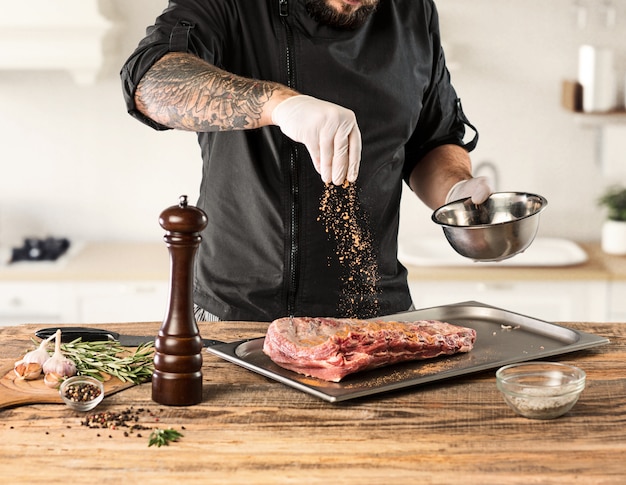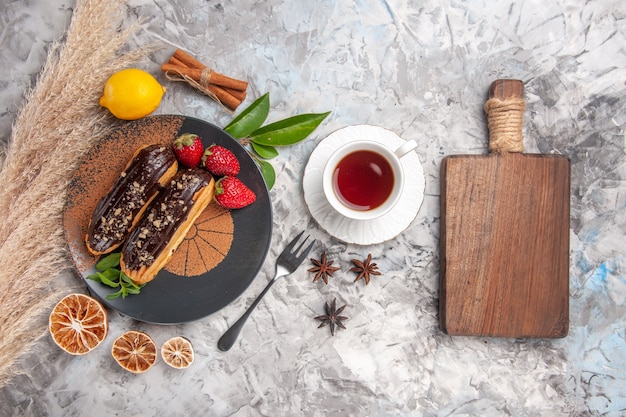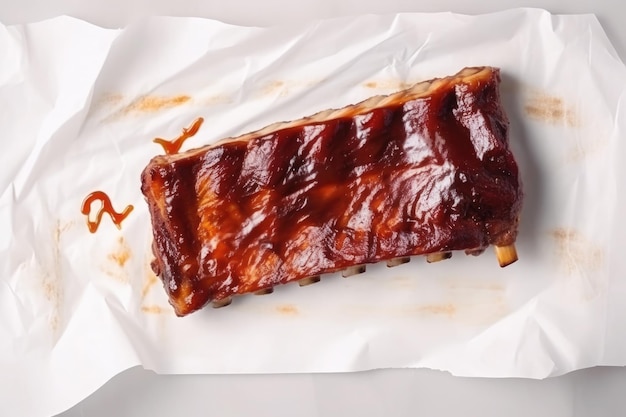There's something undeniably special about a standing rib roast. It's the kind of dish that elevates a meal to a celebratory occasion. The rich, succulent meat, the satisfying aroma that fills the house, the sense of occasion – it all just screams "special." But the idea of cooking a whole standing rib roast can feel daunting, especially if you're only feeding a few people.
For years, I've been a huge fan of standing rib roasts, and I've discovered that a small batch version can be just as impressive and delicious as its larger counterpart. It's all about understanding the process, selecting the right cut, and mastering the technique. This article will guide you through every step, from choosing the perfect cut to carving and serving, so you can enjoy the magic of a standing rib roast even if you're only cooking for two.
(Part 1) The Cut: The Foundation of a perfect roast

choosing the right cut for a Small Batch
The key to a great standing rib roast lies in the cut. It's the foundation of the dish, so choosing well is essential. For a small batch, you want a cut that's manageable yet still delivers that impressive visual and flavour impact.
My go-to for smaller gatherings is the "Standing Rib Roast, 3-4 Ribs". This cut typically weighs in at around 4-6 pounds, providing enough meat for a few people without feeling overwhelming. It's also easier to handle and carve than larger roasts.
What to Look For When Selecting Your Roast
When you're at the butcher counter, keep your eyes peeled for these key qualities:
- Marbling: Marbling refers to the fat streaks woven throughout the meat. This fat is essential for a juicy, flavorful, and tender roast. Look for a cut with good, even marbling throughout. It's the key to ensuring a melt-in-your-mouth experience.
- Color: The meat should have a rich, deep red color. This indicates freshness and good quality. Steer clear of any discoloration, greenish hues, or off-putting smells, which might suggest that the meat isn't as fresh as it should be.
- Feel: The meat should feel firm and springy to the touch. It shouldn't feel mushy or overly soft, which could signal a lack of freshness.
Prime vs. Choice: Understanding the Grades
You'll often see two main grades for standing rib roast: Prime and Choice. These grades are based on the amount of marbling, which affects the tenderness and flavor. Here's a breakdown:
| Grade | Marbling | Tenderness | Flavor | Price |
|---|---|---|---|---|
| Prime | More marbling | More tender | More flavorful | Higher price |
| Choice | Less marbling | Less tender | Less flavorful | Lower price |
Prime is considered the top-tier grade, offering the most marbling and a richer flavour. However, Choice can still be a delicious option, especially if you're watching your budget. I've had great results with both grades, so don't feel like you need to splurge on Prime to enjoy a great roast.
(Part 2) Preparing the Roast: Layering in Flavor

Seasoning: The Secret to a Delicious Roast
Seasoning is the art of transforming a simple piece of meat into something truly special. The right seasoning blend can bring out the best in your roast, creating a symphony of flavor that will have everyone reaching for seconds.
My approach to seasoning is simple yet effective: I believe in letting the natural flavors of the meat shine through, while adding just enough seasoning to enhance its richness.
Here's my go-to seasoning blend for a standing rib roast:
- Salt: Use coarse kosher salt, as it seasons more evenly and doesn't draw moisture out of the meat like table salt. This helps you achieve a perfectly seasoned crust without drying out the roast.
- Freshly Ground Black Pepper: Nothing beats the flavor and aroma of freshly ground pepper. I always grind my own peppercorns to unlock the full potential of the spice.
- Garlic Powder: A subtle yet essential addition, garlic powder adds a savory depth to the roast, complementing its rich flavors.
- Onion Powder: Like garlic powder, onion powder adds another layer of complexity to the flavor profile, contributing a sweet and savory note.
Before seasoning, I always pat the rib roast dry with paper towels. This allows the seasoning to adhere better to the surface of the meat, ensuring a delicious, well-seasoned crust. Then, I generously rub the seasoning blend all over the roast, making sure to cover every inch evenly. You can use your hands or a small spoon for this, whatever feels comfortable.
The Power of Fresh Herbs
While the basic seasoning blend is a great foundation, the addition of fresh herbs elevates the roast to another level. Herbs add another dimension of flavour and aroma, making the roast truly unforgettable.
Some of my favorite herbs for standing rib roast include:
- Rosemary: Its pungent, pine-like flavor adds a wonderfully robust note that complements the richness of the meat.
- Thyme: This herb offers a warm, earthy flavor that adds a touch of subtle herbaceousness to the roast.
- Sage: With its slightly bitter, yet aromatic flavor, sage balances the richness of the meat, creating a complex and satisfying flavor profile.
I always use fresh herbs whenever possible for the most potent flavour. Finely chop them and sprinkle them over the seasoned roast before cooking. This ensures the herbs are evenly distributed and infuse their wonderful aromas into the meat as it cooks.
(Part 3) Cooking the Roast: Achieving Perfection

The Oven: Your Culinary Partner
When it comes to cooking a standing rib roast, using the right oven is key. While convection ovens can be great for many things, they can dry out the meat, leading to a less than ideal result. I recommend sticking to a conventional oven for this recipe.
The Importance of Room Temperature
Before you even think about putting the roast in the oven, it's essential to let it come to room temperature. This ensures even cooking and prevents the centre of the roast from being cold while the outside is overcooked.
Remove the roast from the refrigerator at least 30 minutes before cooking, allowing it to gradually warm up to room temperature. This makes a big difference in the final result, so don't skip this step!
The "Sear and Slow" Method: A Proven Technique
My preferred method for cooking a standing rib roast is the "sear and slow" method. This technique combines high heat for an initial sear, creating a beautifully browned crust, followed by slow cooking at a lower temperature to ensure the meat is cooked perfectly through and tender.
Searing: Preheat your oven to 450 degrees Fahrenheit (230 degrees Celsius). Place the seasoned roast on a roasting rack set inside a roasting pan. The rack allows for air circulation around the roast, promoting even cooking. Cook the roast for 15-20 minutes, or until the exterior is nicely browned and develops a crispy crust. This initial sear locks in the juices and creates a delicious crust that adds another layer of flavour.
Slow-Cooking: After the initial sear, reduce the oven temperature to 325 degrees Fahrenheit (160 degrees Celsius). Continue cooking the roast for about 15-20 minutes per pound, or until it reaches an internal temperature of 135 degrees Fahrenheit (57 degrees Celsius) for medium-rare. You can adjust the cooking time based on your desired level of doneness.
Resting: Once the roast has reached the desired internal temperature, remove it from the oven and let it rest for 15-20 minutes before carving. This resting time allows the juices to redistribute throughout the meat, resulting in a more tender and flavorful roast.
(Part 4) Monitoring Doneness: A Culinary Compass
Temperature is Key: A meat thermometer is Your Friend
Doneness is critical to a perfect standing rib roast. You want to ensure that the meat is cooked evenly throughout, without being overcooked (tough and dry) or undercooked (potentially unsafe).
The best tool for achieving the perfect doneness is a meat thermometer. Insert the thermometer into the thickest part of the roast, making sure it doesn't touch any bone, and check the internal temperature.
Internal Temperature Chart: A Guide to Doneness
Here's a handy guide to internal temperatures for different levels of doneness:
| Level of Doneness | Internal Temperature (Fahrenheit) | Internal Temperature (Celsius) |
|---|---|---|
| Rare | 125-130°F | 52-54°C |
| Medium-Rare | 130-135°F | 54-57°C |
| Medium | 135-140°F | 57-60°C |
| Medium-Well | 140-145°F | 60-63°C |
| Well-Done | 145-150°F | 63-66°C |
Keep in mind that these are just guidelines. The actual internal temperature might vary slightly depending on the thickness of the roast and your personal preference. As the roast cooks, the internal temperature will rise gradually. Monitor it regularly using a meat thermometer, adjusting the cooking time as needed to ensure the roast reaches your desired level of doneness.
(Part 5) Serving the Roast: A Celebration of Flavor
Carving the Roast: A Skill Worth Mastering
Once the roast has rested, it's time to carve it. This is a simple but elegant process that requires a bit of practice.
First, remove the roast from the roasting pan and place it on a cutting board.
For carving, use a sharp carving knife. I prefer a boning knife for this task. It's thin and flexible, making it easier to navigate around the bones without tearing the meat.
Begin by slicing the roast into individual ribs. Cut through the meat between the bones, working your way down the entire length of the roast. Once you've sliced through all the ribs, carve each rib into thin slices, cutting against the grain of the meat. This helps ensure tender, juicy slices that are easier to chew.
As you carve, try to avoid cutting through the fat cap. This layer of fat adds flavor and moisture to the meat, so leaving it intact will enhance the overall taste and texture.
Accompanying Delights: Complementary Sides
A standing rib roast is a feast for the senses, and it deserves to be accompanied by a selection of equally delicious sides. Here are some of my favorites:
- Roasted Vegetables: The flavors of roasted vegetables, such as Brussels sprouts, carrots, or potatoes, complement the richness of the roast beautifully. The caramelization and roasting process brings out their natural sweetness and creates a satisfying textural contrast.
- Creamy Polenta: Its creamy texture and neutral flavor provide a comforting counterpoint to the robust roast. Polenta also helps absorb the delicious juices from the roast, making it even more flavorful.
- Sautéed Greens: A simple side of sautéed greens, such as spinach or kale, adds a touch of freshness and vibrancy to the meal. The bright green colour also provides a beautiful visual contrast to the rich brown roast.
- Garlic Bread: A classic pairing that enhances the savory flavors of the roast. The buttery, garlicky goodness is a perfect accompaniment to the tender meat and complements the rich flavours of the roast.
A Touch of Sauce: Elevating the Experience
While a standing rib roast is delicious on its own, a drizzle of sauce can elevate the dish to new heights. It adds another layer of flavor and richness, making it even more satisfying.
You can use a store-bought sauce or make your own. Here are some ideas:
- Au Jus: The juices that accumulate in the roasting pan after cooking can be strained and used as a flavorful sauce. It's a simple and incredibly delicious way to make a sauce that complements the roast perfectly.
- Red Wine Sauce: A classic sauce that adds a rich and complex flavor to the roast. The combination of red wine, herbs, and sometimes a touch of cream creates a delicious sauce that pairs beautifully with the savory meat.
- Horseradish Sauce: A tangy and spicy sauce that cuts through the richness of the meat. It adds a refreshing contrast to the richness of the roast, balancing the flavors and creating a more exciting experience.
(Part 6) Leftovers: A Culinary Treasure
Making the Most of Leftovers: Creative Recipes
Standing rib roast is a dish that lends itself beautifully to leftovers. There's no need to waste even a morsel of this delicious meat!
Here are a few ideas for using up leftover roast:
- roast beef sandwiches: Slice the leftover roast thinly and pile it high on toasted bread with your favorite toppings, such as cheese, mustard, and horseradish sauce. It's a quick and satisfying lunch or dinner option.
- Beef Hash: Dice the leftover roast and saute it with onions and potatoes for a hearty and flavorful breakfast or brunch dish. The combination of meat, potatoes, and onions is a classic comfort food, and leftover roast beef adds a delicious twist.
- Beef Soup: Use the leftover roast to add flavor and protein to your favorite beef soup recipe. The roast adds a rich, savory base to the soup, making it even more satisfying.
- Beef and Vegetable Stir-Fry: Stir-fry the leftover roast with your favorite vegetables for a quick and satisfying weeknight meal. This is a great way to use up leftover roast and create a healthy and flavorful meal in minutes.
Leftover roast can be stored in the refrigerator for up to 3-4 days. If you want to freeze the roast, wrap it tightly in plastic wrap and aluminum foil, and store it in the freezer for up to 3 months.
(Part 7) Beyond the Basics: Exploring Variations
Adding a Touch of Creativity: Flavour Experimentation
While the classic standing rib roast is a timeless favorite, don't be afraid to experiment with different flavors and techniques. There's a world of possibilities waiting to be explored!
Here are a few ideas for adding your own personal touch to the dish:
- Rub with Spices: Instead of using a basic seasoning blend, try creating your own spice rub with different combinations of spices, such as cumin, coriander, paprika, or chili powder. This allows you to customize the flavor profile to your liking, adding warmth, spice, or smoky notes.
- Glaze with Honey or Maple Syrup: Add a touch of sweetness and richness to the roast by glazing it with honey or maple syrup towards the end of cooking. The glaze caramelizes as it cooks, creating a delicious crust and adding a touch of sweetness that complements the savory meat.
- Stuff with Herbs and Vegetables: Stuff the roast with aromatic herbs, such as rosemary, thyme, and sage, along with vegetables like onions, garlic, and carrots. This creates a flavorful stuffing that infuses the roast with additional depth and aroma. It also adds a beautiful visual element to the roast.
Small Batch, Big Flavor: The Power of Quality
Remember, a small batch standing rib roast is all about quality, not quantity. Choose a good-quality cut of meat, season it generously, and cook it to perfection. The same principles apply to smaller roasts, but you'll simply adjust the ingredients and cooking time accordingly.
A small batch standing rib roast is a perfect option for intimate dinners, romantic evenings, or special occasions. It's a dish that's sure to impress, even if you're only cooking for two.
(Part 8) FAQs: Answers to Common Questions
Q: How long do I need to let the roast rest after cooking?
A: It's crucial to let the roast rest for 15-20 minutes after cooking. This allows the juices to redistribute throughout the meat, resulting in a more tender and flavorful roast. This is an essential step in the process, so don't skip it!
Q: Can I cook a standing rib roast in a slow cooker?
A: While a slow cooker can be used to cook a standing rib roast, it's not the ideal method for this type of cut. Slow cookers tend to cook meat more evenly, which can lead to a less flavorful and less tender roast. The "sear and slow" method using a conventional oven is generally the best way to cook a standing rib roast.
Q: Can I cook a standing rib roast in a pressure cooker?
A: Yes, you can cook a standing rib roast in a pressure cooker. However, you'll need to adjust the cooking time and temperature. It's best to follow a recipe specifically designed for pressure cooking standing rib roast.
Q: What's the best way to reheat leftover roast?
A: The best way to reheat leftover roast is in a low oven at 325 degrees Fahrenheit (160 degrees Celsius) until warmed through. You can also reheat it in a microwave, but this can make the meat dry and tough. The oven method is generally the most effective for retaining moisture and flavor.
Q: What are some other ways to use leftover standing rib roast?
A: Leftover standing rib roast is a versatile ingredient that can be used in a variety of dishes. You can use it to make roast beef sandwiches, beef hash, beef soup, beef and vegetable stir-fry, or add it to your favorite pasta dishes. Get creative and experiment with different ways to use up your leftovers!
Everyone is watching

Perfect Rice Every Time: The Ultimate Guide to Cooking Rice
Cooking TipsAs a self-proclaimed foodie, I've always been a bit obsessed with rice. It's the foundation of countless cuisi...

Prime Rib Roast Cooking Time Chart: Per Pound Guide
Cooking TipsPrime rib roast. Just the name conjures images of lavish dinners, crackling fires, and hearty laughter. It’s ...

The Ultimate Guide to Cooking Asparagus: Tips, Techniques, and Recipes
Cooking TipsAsparagus. The mere mention of this spring delicacy conjures up images of vibrant green spears, crisp and burs...

Ultimate Guide to Cooking the Perfect Thanksgiving Turkey
Cooking TipsThanksgiving. Just the word conjures up images of overflowing tables laden with delicious food, the scent of r...

How Long to Bake Potatoes in the Oven (Perfect Every Time)
Cooking TipsBaked potatoes are a staple in my kitchen. They're incredibly versatile, delicious, and surprisingly easy to m...
